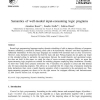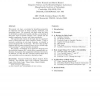102
click to vote
GRAMMARS
2000
15 years 11 days ago
2000
Inthis paper, we aim at giving alogical account of the representationalist view on minimalist grammars by refering to the notion of Proof-Net in Linear Logic. We propose at the sam...
83
Voted
FUIN
2000
15 years 11 days ago
2000
The nondeterministic information logic NIL has been introduced by Orlowska and Pawlak in 1984 as a logic for reasoning about total information systems with the similarity, the forw...
115
Voted
CORR
2002
Springer
15 years 11 days ago
2002
Springer
Sound and complete axiomatizations are provided for a number of different logics involving modalities for knowledge and time. These logics arise from different choices for various ...
116
Voted
ENTCS
2000
15 years 11 days ago
2000
Abstract. Logic programming languages based on linear logic are of both theoretical and practical interest, particulaly because such languages can be seen as providing a logical ba...
75
Voted
EATCS
2000
15 years 11 days ago
2000
One of the previous articles in this column was devoted to the zero-one laws for a number of logics playing prominent role in finite model theory: first-order logic FO, the extens...
112
Voted
CL
2000
Springer
15 years 12 days ago
2000
Springer
Recent logic programming languages employ dynamic scheduling of calls to improve e ciency of programs. Dynamic scheduling is realized by allowing some calls to be dynamically &quo...
85
Voted
CSL
2004
Springer
15 years 12 days ago
2004
Springer
Abstract. A new class of languages of infinite words is introduced, called the maxregular languages, extending the class of -regular languages. The class has two equivalent descrip...
106
click to vote
CORR
2004
Springer
15 years 12 days ago
2004
Springer
We have previously introduced role logic as a notation for describing properties of relational structures in shape analysis, databases and knowledge bases. A natural fragment of ro...
117
click to vote
CORR
2004
Springer
15 years 12 days ago
2004
Springer
We present role logic, a notation for describing properties of relational structures in shape analysis, databases, and knowledge bases. We construct role logic using the ideas of ...
115
click to vote
CORR
2004
Springer
15 years 12 days ago
2004
Springer
Abstract. Spatial conjunction is a powerful construct for reasoning about dynamically allocated data structures, as well as concurrent, distributed and mobile computation. While re...







